Holly Thompson's Blog, page 27
August 23, 2013
Lowell, Monkey Dance and the Southeast Asian Water Festival
Every August now since 1997, the Lowell Southeast Asian Water Festival celebrates Cambodian and other Southeast Asian communities of Lowell, Massachusetts. This year I joined the Angkor Dance Troupe at their stall to sell donated copies of The Language Inside, which I wrote with key input and guidance from the troupe and members of the Lowell Cambodian community.
I enjoyed chatting with Angkor Dance Troupe president Linda Sopheap Sou at the dance troupe's stall. And have you seen Monkey Dance, the beautiful, moving 2004 documentary by Julie Mallozzi about three teens, children of Cambodian refugees, coming of age in Lowell, MA? Some ten years after the filming, the three teens featured in the film are now role-model adults--in the arts, in health care and in education--in the Lowell community. How inspiring is this--Monkey Dance Reunion photo!
 Monkey Dance reunion: Sochenda Uch, Linda Sopheap Sou, Samnang HorI was also able to thank individuals in the Lowell community who'd helped guide me in creating the Cambodian characters and situations in The Language Inside, individuals such as Sonith Peou, Sidney Liang and Dorcas Grigg-Saito of the Lowell Community Health Center.
Monkey Dance reunion: Sochenda Uch, Linda Sopheap Sou, Samnang HorI was also able to thank individuals in the Lowell community who'd helped guide me in creating the Cambodian characters and situations in The Language Inside, individuals such as Sonith Peou, Sidney Liang and Dorcas Grigg-Saito of the Lowell Community Health Center.
 Sonith Peou at the Lowell Community Health Center boothI also had a chance to chat with Angkor Dance Troupe board member and poet Samkhann Khoeun, translator and editor of O, Maha Mount Dagrek! mentioned in The Language Inside.
Sonith Peou at the Lowell Community Health Center boothI also had a chance to chat with Angkor Dance Troupe board member and poet Samkhann Khoeun, translator and editor of O, Maha Mount Dagrek! mentioned in The Language Inside.
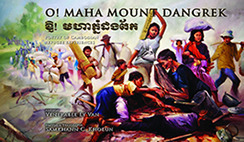
Of course I sampled the great food in the stalls set up all along the river bank.

And I gave mega thanks to the ever inspiring Angkor Dance Troupe founder and program director Tim Thou . . .
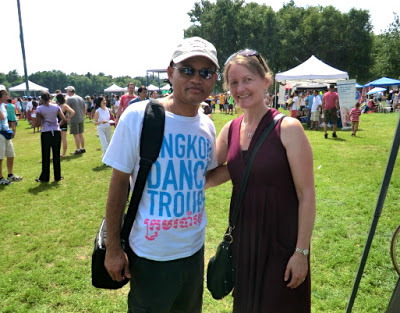
and watched the Angkor Dance Troupe dancers prepare
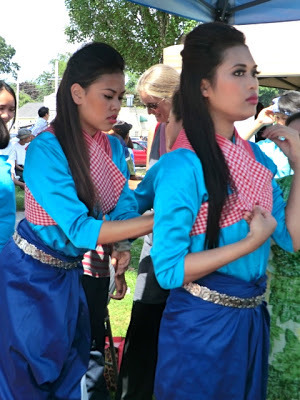 and dance
and dance
 Angkor Dance Troupe--Moonlight Dance
Angkor Dance Troupe--Moonlight Dance
 Angkor Dance Troupe--Fishing Dance
Angkor Dance Troupe--Fishing Dance
and I thanked them for all their encouragement, inspiration and support while I was researching and writing my novel.
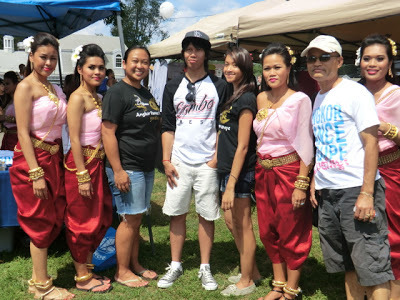 Tim Thou and some members of the Angkor Dance Troupe
Tim Thou and some members of the Angkor Dance Troupe
If you're in Massachusetts in August, don't miss the Lowell Southeast Asian Water Festival, and while you're there, take a look around you at the amazing individuals making a difference in this Massachusetts city.
I enjoyed chatting with Angkor Dance Troupe president Linda Sopheap Sou at the dance troupe's stall. And have you seen Monkey Dance, the beautiful, moving 2004 documentary by Julie Mallozzi about three teens, children of Cambodian refugees, coming of age in Lowell, MA? Some ten years after the filming, the three teens featured in the film are now role-model adults--in the arts, in health care and in education--in the Lowell community. How inspiring is this--Monkey Dance Reunion photo!
 Monkey Dance reunion: Sochenda Uch, Linda Sopheap Sou, Samnang HorI was also able to thank individuals in the Lowell community who'd helped guide me in creating the Cambodian characters and situations in The Language Inside, individuals such as Sonith Peou, Sidney Liang and Dorcas Grigg-Saito of the Lowell Community Health Center.
Monkey Dance reunion: Sochenda Uch, Linda Sopheap Sou, Samnang HorI was also able to thank individuals in the Lowell community who'd helped guide me in creating the Cambodian characters and situations in The Language Inside, individuals such as Sonith Peou, Sidney Liang and Dorcas Grigg-Saito of the Lowell Community Health Center. Sonith Peou at the Lowell Community Health Center boothI also had a chance to chat with Angkor Dance Troupe board member and poet Samkhann Khoeun, translator and editor of O, Maha Mount Dagrek! mentioned in The Language Inside.
Sonith Peou at the Lowell Community Health Center boothI also had a chance to chat with Angkor Dance Troupe board member and poet Samkhann Khoeun, translator and editor of O, Maha Mount Dagrek! mentioned in The Language Inside.
Of course I sampled the great food in the stalls set up all along the river bank.

And I gave mega thanks to the ever inspiring Angkor Dance Troupe founder and program director Tim Thou . . .

and watched the Angkor Dance Troupe dancers prepare
 and dance
and dance Angkor Dance Troupe--Moonlight Dance
Angkor Dance Troupe--Moonlight Dance
 Angkor Dance Troupe--Fishing Dance
Angkor Dance Troupe--Fishing Danceand I thanked them for all their encouragement, inspiration and support while I was researching and writing my novel.
 Tim Thou and some members of the Angkor Dance Troupe
Tim Thou and some members of the Angkor Dance TroupeIf you're in Massachusetts in August, don't miss the Lowell Southeast Asian Water Festival, and while you're there, take a look around you at the amazing individuals making a difference in this Massachusetts city.
Published on August 23, 2013 23:52
August 15, 2013
2013 SCBWI LA Summer Conference Recap
Earlier this month, I attended the SCBWI summer conference in Los Angeles. I love this conference--meeting and reconnecting with other children's lit writers, illustrators, editors and agents from around the world, catching all the great keynotes and attending as many breakout sessions on writing for young people as possible.
 sunset at the SCBWI LA conferenceSessions I loved at this conference included editor Andrea Pinkney on writing nonfiction; author Matt de la Pena on school visits; Deborah Halverson's state of the industry talk; editor Allyn Johnston on picture books; editor Arthur Levine on poetry; and Richard Peck on writing.
sunset at the SCBWI LA conferenceSessions I loved at this conference included editor Andrea Pinkney on writing nonfiction; author Matt de la Pena on school visits; Deborah Halverson's state of the industry talk; editor Allyn Johnston on picture books; editor Arthur Levine on poetry; and Richard Peck on writing.
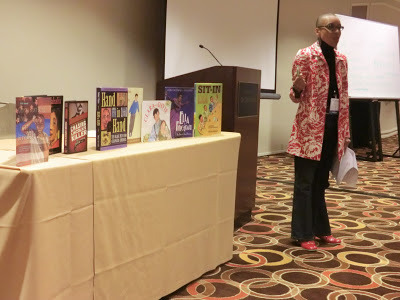 Author/Editor Andrea Davis Pinkney on nonfictionHere are some favorite quotes from the three days of conference:
Author/Editor Andrea Davis Pinkney on nonfictionHere are some favorite quotes from the three days of conference:
Laurie Halse Anderson "Books are proof that humans can do magic."
Jon Scieszka "Don't put kids to sleep--wake them up for God's sake!"
Andrea Pinkney "I don't care about genre, length. I publish beyond category."
Peter Lerangis "If I can give a child an hour, a day, a week of hope, then I've done my job."
Mac Barnett "Find that space between truth and lies."
Matt de le Pena "It's all about how hard you work when nobody's looking."
Arthur Levine "I really like sad poems for a nice focused punch of sadness."
David Wiesner "Explore every side of an idea. Wallow in your process. Follow that story."
Allyn Johnston "I think of the picture book as a piece of theatre."
Richard Peck "Writing is the act of getting your brain to bleed onto a blank piece of paper in an empty room."
This year there was impressive representation from Japan . . .
 SCBWI Japan membersand SCBWI Japan member Leza Lowitz showcased Jet Black and the Ninja Wind by Leza and her husband Shogo Oketani at the booksale.
SCBWI Japan membersand SCBWI Japan member Leza Lowitz showcased Jet Black and the Ninja Wind by Leza and her husband Shogo Oketani at the booksale.
 Author Leza LowitzThe conference affords the chance for international regional advisors to meet and plan, and we had international RAs from Japan, Australia, Switzerland, India and Mexico, and the international social was attended by members from those countries plus Peru, the UK and Canada. One attendee, Jean Bransfield Graham, sought out SCBWI Japan folks to share her picture book Flicker Flash being published in Japanese as Chika-chika pikari by Fukuinkan.
Author Leza LowitzThe conference affords the chance for international regional advisors to meet and plan, and we had international RAs from Japan, Australia, Switzerland, India and Mexico, and the international social was attended by members from those countries plus Peru, the UK and Canada. One attendee, Jean Bransfield Graham, sought out SCBWI Japan folks to share her picture book Flicker Flash being published in Japanese as Chika-chika pikari by Fukuinkan.
 Author Jean Bransfield GrahamI loved catching up with friends like Emily Jiang, whose picture book Summoning the Phoenix will be published by Shen's Books in 2014.
Author Jean Bransfield GrahamI loved catching up with friends like Emily Jiang, whose picture book Summoning the Phoenix will be published by Shen's Books in 2014.
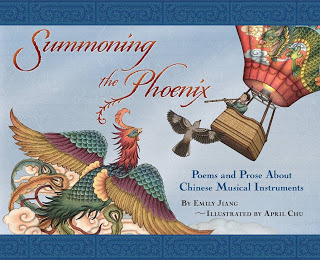
And I had the chance to meet with my agent Jamie Weiss Chilton while at the conference and to meet another of her clients, picture book author Jean Reagan, who, it turns out had grown up in Tohoku, Japan.
A personal highlight was being approached out of the blue by California bookseller Cathy Linka of Flintridge Bookstore who nearly made me weep with her words: "What you're doing in your writing is so fresh and different and inclusive and has such heart. Orchards is a great book, and The Language Inside is even better."
And it's always great to catch up with the amazing Lee Wind, blogger extraordinaire and whose fiction and nonfiction I can't wait to read in print.
For more on the SCBWI LA summer conference see the SCBWI Team Blog coverage of the conference.
 sunset at the SCBWI LA conferenceSessions I loved at this conference included editor Andrea Pinkney on writing nonfiction; author Matt de la Pena on school visits; Deborah Halverson's state of the industry talk; editor Allyn Johnston on picture books; editor Arthur Levine on poetry; and Richard Peck on writing.
sunset at the SCBWI LA conferenceSessions I loved at this conference included editor Andrea Pinkney on writing nonfiction; author Matt de la Pena on school visits; Deborah Halverson's state of the industry talk; editor Allyn Johnston on picture books; editor Arthur Levine on poetry; and Richard Peck on writing.  Author/Editor Andrea Davis Pinkney on nonfictionHere are some favorite quotes from the three days of conference:
Author/Editor Andrea Davis Pinkney on nonfictionHere are some favorite quotes from the three days of conference:Laurie Halse Anderson "Books are proof that humans can do magic."
Jon Scieszka "Don't put kids to sleep--wake them up for God's sake!"
Andrea Pinkney "I don't care about genre, length. I publish beyond category."
Peter Lerangis "If I can give a child an hour, a day, a week of hope, then I've done my job."
Mac Barnett "Find that space between truth and lies."
Matt de le Pena "It's all about how hard you work when nobody's looking."
Arthur Levine "I really like sad poems for a nice focused punch of sadness."
David Wiesner "Explore every side of an idea. Wallow in your process. Follow that story."
Allyn Johnston "I think of the picture book as a piece of theatre."
Richard Peck "Writing is the act of getting your brain to bleed onto a blank piece of paper in an empty room."
This year there was impressive representation from Japan . . .
 SCBWI Japan membersand SCBWI Japan member Leza Lowitz showcased Jet Black and the Ninja Wind by Leza and her husband Shogo Oketani at the booksale.
SCBWI Japan membersand SCBWI Japan member Leza Lowitz showcased Jet Black and the Ninja Wind by Leza and her husband Shogo Oketani at the booksale.  Author Leza LowitzThe conference affords the chance for international regional advisors to meet and plan, and we had international RAs from Japan, Australia, Switzerland, India and Mexico, and the international social was attended by members from those countries plus Peru, the UK and Canada. One attendee, Jean Bransfield Graham, sought out SCBWI Japan folks to share her picture book Flicker Flash being published in Japanese as Chika-chika pikari by Fukuinkan.
Author Leza LowitzThe conference affords the chance for international regional advisors to meet and plan, and we had international RAs from Japan, Australia, Switzerland, India and Mexico, and the international social was attended by members from those countries plus Peru, the UK and Canada. One attendee, Jean Bransfield Graham, sought out SCBWI Japan folks to share her picture book Flicker Flash being published in Japanese as Chika-chika pikari by Fukuinkan. Author Jean Bransfield GrahamI loved catching up with friends like Emily Jiang, whose picture book Summoning the Phoenix will be published by Shen's Books in 2014.
Author Jean Bransfield GrahamI loved catching up with friends like Emily Jiang, whose picture book Summoning the Phoenix will be published by Shen's Books in 2014. 
And I had the chance to meet with my agent Jamie Weiss Chilton while at the conference and to meet another of her clients, picture book author Jean Reagan, who, it turns out had grown up in Tohoku, Japan.
A personal highlight was being approached out of the blue by California bookseller Cathy Linka of Flintridge Bookstore who nearly made me weep with her words: "What you're doing in your writing is so fresh and different and inclusive and has such heart. Orchards is a great book, and The Language Inside is even better."
And it's always great to catch up with the amazing Lee Wind, blogger extraordinaire and whose fiction and nonfiction I can't wait to read in print.
For more on the SCBWI LA summer conference see the SCBWI Team Blog coverage of the conference.
Published on August 15, 2013 11:45
July 25, 2013
Poetry Friday: Verse and Writing Headlong into Grief
Deborah Lytton recently interviewed me for her blog Adventures in Writing.
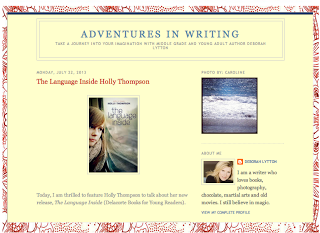
In this Adventures in Writing interview, Debby, who has also written about loss, asked some questions that brought me back to the raw grief that fed Orchards and the main character Kana's struggles as a suicide survivor, and to the losses that hit directly or indirectly at the main character Emma in my new novel The Language Inside. "How do you work through the pain of your characters?" Debby asked. As I indicate in my answer to her, I manage in part by finding uninterrupted time alone to allow for plenty of crying.
On Laura Shovan's Author Amok blog, this week her Poetry Friday topic is Writing about Difficult Subjects.

In the post, Laura references one of my favorite poets, Lucille Clifton, and the advice she gave to poets to bear witness to life and events that are difficult. I credit Lucille Clifton's poems with giving me the courage to bear witness and to create story from painful events. There are some Lucille Clifton poems that I read over and over, year in, year out, for a shot of that courage.
The post also discusses an interview with Jacqueline Jules about her poem "The Stick in the Boy's Hand" about sexual abuse. Comments on that Author Amok post led me to an interview by Robyn Hood Black of Margarita Engle in which Margarita talks about writing on the difficult subjects war, slavery and torture using the verse novel form.
When it comes to writing about difficult subjects, and how to do it, my answer is often poetry with a plot. The distilled, spare nature of verse enables raw, difficult stories to be told while still leaving breathing room for the reader, as well as the narrator. Verse is a natural vehicle, for intense, internal stories.
In Orchards, in the chapter "Blink" Kana is stunned by a rural Japanese custom of hanging a live crow in the orchard to serve as a scarecrow. Her reaction is instant, physical, and grief-drenched, yet she hardly mentions her classmate Ruth, who'd died. In The Language Inside Emma is traumatized by the magnitude of loss, of places, things and people, who are simply "gone" after the 2011 Japan tsunami, and she writes about fears for her mother in a chilling piece of short verse in which she compares breasts to bamboo shoots being harvested. Verse allowed me to use rhythms, pacing, repetition, white space and incisive imagery to convey in just a few words topics that have been difficult for me to face--the death of loved ones by suicide, the trauma of the 2011 tsunami, my sister's mastectomy, and more.
Besides using verse, I can tackle difficult topics if I find the vein of humor or lightness in a story. Even if that lightness remains shadowed much of the time, that yin and yang of a story--grief or despair contrasted with humor or lightness--can guide a narrative forward, and help the writer navigate those painful aspects of a story or poem. Lucille Clifton and Sherman Alexie are masters at this.
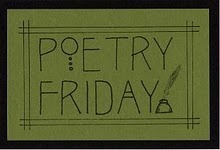 And so, taking up the Author Amok question, how do you write about difficult subjects?
And so, taking up the Author Amok question, how do you write about difficult subjects?

In this Adventures in Writing interview, Debby, who has also written about loss, asked some questions that brought me back to the raw grief that fed Orchards and the main character Kana's struggles as a suicide survivor, and to the losses that hit directly or indirectly at the main character Emma in my new novel The Language Inside. "How do you work through the pain of your characters?" Debby asked. As I indicate in my answer to her, I manage in part by finding uninterrupted time alone to allow for plenty of crying.
On Laura Shovan's Author Amok blog, this week her Poetry Friday topic is Writing about Difficult Subjects.

In the post, Laura references one of my favorite poets, Lucille Clifton, and the advice she gave to poets to bear witness to life and events that are difficult. I credit Lucille Clifton's poems with giving me the courage to bear witness and to create story from painful events. There are some Lucille Clifton poems that I read over and over, year in, year out, for a shot of that courage.
The post also discusses an interview with Jacqueline Jules about her poem "The Stick in the Boy's Hand" about sexual abuse. Comments on that Author Amok post led me to an interview by Robyn Hood Black of Margarita Engle in which Margarita talks about writing on the difficult subjects war, slavery and torture using the verse novel form.
When it comes to writing about difficult subjects, and how to do it, my answer is often poetry with a plot. The distilled, spare nature of verse enables raw, difficult stories to be told while still leaving breathing room for the reader, as well as the narrator. Verse is a natural vehicle, for intense, internal stories.
In Orchards, in the chapter "Blink" Kana is stunned by a rural Japanese custom of hanging a live crow in the orchard to serve as a scarecrow. Her reaction is instant, physical, and grief-drenched, yet she hardly mentions her classmate Ruth, who'd died. In The Language Inside Emma is traumatized by the magnitude of loss, of places, things and people, who are simply "gone" after the 2011 Japan tsunami, and she writes about fears for her mother in a chilling piece of short verse in which she compares breasts to bamboo shoots being harvested. Verse allowed me to use rhythms, pacing, repetition, white space and incisive imagery to convey in just a few words topics that have been difficult for me to face--the death of loved ones by suicide, the trauma of the 2011 tsunami, my sister's mastectomy, and more.
Besides using verse, I can tackle difficult topics if I find the vein of humor or lightness in a story. Even if that lightness remains shadowed much of the time, that yin and yang of a story--grief or despair contrasted with humor or lightness--can guide a narrative forward, and help the writer navigate those painful aspects of a story or poem. Lucille Clifton and Sherman Alexie are masters at this.
 And so, taking up the Author Amok question, how do you write about difficult subjects?
And so, taking up the Author Amok question, how do you write about difficult subjects?
Published on July 25, 2013 20:28
July 23, 2013
Bee is for Boston--A Glimpse at Urban Beekeeping
I'm spending time in Boston this summer, and thanks to my sister-in-law, a new beekeeper (or "newbee"), I've had a chance to learn a bit about urban beekeeping.
Did you know about the annual Boston Tour de Hives--a bicycle tour of Boston honeybee hives?
Did you know that various Boston hotels have rooftop apiaries?
And, have you ever listened to beekeepers talking? The language--bearding, swarm emergence, unemerged queens, supersedure, queen cups, surplus queens--is enough to make you want to write a bee novel. Well almost.
Here's a bit of bee-viewing from the day that beekeepers Dean Stiglitz and Laurie Herboldsheimer of Golden Rule Honey (and authors of The Complete Idiot's Guide to Beekeeping) came to do a hive inspection and offer guidance on the new hives:
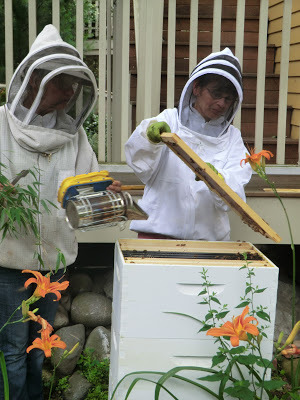 smoking to calm the bees while opening the hive
smoking to calm the bees while opening the hive
 inspecting comb
inspecting comb
 searching for a queen and looking for fresh brood
searching for a queen and looking for fresh brood
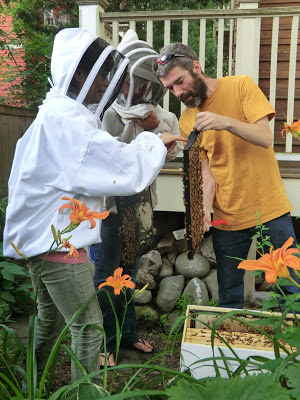 first taste of honey from these hives
first taste of honey from these hives
 hexagonal comb cell structureAnd if you want to hear a bit of the crazy beekeeping lingo--"genetically stunted queens," "hopelessly queenless," "haploid genetics," "fatally exploding . . . " ahem--then listen to Dean speaking in this video Where Do Bees Come From:
hexagonal comb cell structureAnd if you want to hear a bit of the crazy beekeeping lingo--"genetically stunted queens," "hopelessly queenless," "haploid genetics," "fatally exploding . . . " ahem--then listen to Dean speaking in this video Where Do Bees Come From:
Did you know about the annual Boston Tour de Hives--a bicycle tour of Boston honeybee hives?
Did you know that various Boston hotels have rooftop apiaries?
And, have you ever listened to beekeepers talking? The language--bearding, swarm emergence, unemerged queens, supersedure, queen cups, surplus queens--is enough to make you want to write a bee novel. Well almost.
Here's a bit of bee-viewing from the day that beekeepers Dean Stiglitz and Laurie Herboldsheimer of Golden Rule Honey (and authors of The Complete Idiot's Guide to Beekeeping) came to do a hive inspection and offer guidance on the new hives:
 smoking to calm the bees while opening the hive
smoking to calm the bees while opening the hive
 inspecting comb
inspecting comb
 searching for a queen and looking for fresh brood
searching for a queen and looking for fresh brood
 first taste of honey from these hives
first taste of honey from these hives
 hexagonal comb cell structureAnd if you want to hear a bit of the crazy beekeeping lingo--"genetically stunted queens," "hopelessly queenless," "haploid genetics," "fatally exploding . . . " ahem--then listen to Dean speaking in this video Where Do Bees Come From:
hexagonal comb cell structureAnd if you want to hear a bit of the crazy beekeeping lingo--"genetically stunted queens," "hopelessly queenless," "haploid genetics," "fatally exploding . . . " ahem--then listen to Dean speaking in this video Where Do Bees Come From:
Published on July 23, 2013 18:39
June 21, 2013
Visiting International Students in Kyoto
This week I took a day trip to Kyoto by shinkansen train for an author visit at Doshisha International Junior/Senior High School. I loved visiting this school, full of returnees--Japanese students who have spent significant time abroad, as well as bicultural and intercultural students. For them, the feelings expressed by my character Emma in The Language Inside as she struggles to navigate her unfamiliar homeland had particular resonance--"That's me," they said, and "I know exactly how she felt." Write your stories, I tell them--the world needs to hear from you! The literary world needs so many more intercultural voices.
 Where's Holly?--me with some of the fun students and teachers at Doshisha InternatioanalSarah Ogawa, author of the story "One" in
Tomo: Friendship Through Fiction
did an amazing job coordinating my visit to Doshisha International.
Where's Holly?--me with some of the fun students and teachers at Doshisha InternatioanalSarah Ogawa, author of the story "One" in
Tomo: Friendship Through Fiction
did an amazing job coordinating my visit to Doshisha International.
And I loved hearing from teacher Natsuko Shiokawa who's been working with students using Tomo--I look forward to seeing the resulting short stories.
 Two student teachers at the school had created impressive projects with The Language Inside. In one, students selected a scene and wrote poems for that scene from the point of view of a different character--how cool to read poems from the p.o.v. of Samnang, Madoka, YiaYia, Emma's Yokohama friend Juulia, and her Kamakura friend Shin.
Two student teachers at the school had created impressive projects with The Language Inside. In one, students selected a scene and wrote poems for that scene from the point of view of a different character--how cool to read poems from the p.o.v. of Samnang, Madoka, YiaYia, Emma's Yokohama friend Juulia, and her Kamakura friend Shin.
Another project had the students making posters. Here are a few.

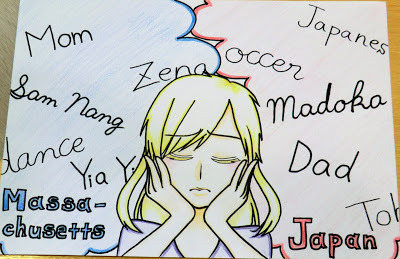
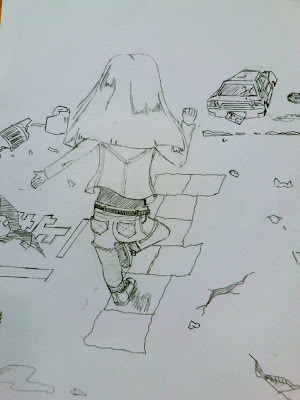


Yet another teacher had students making a trailer for The Language Inside--I was happy to have the chance to peek at their work in progress, and I look forward to seeing the final cut.
It was a great day meeting the students and teachers of Doshisha International, and of course . . . you gotta love Shinkansen travel!

 Where's Holly?--me with some of the fun students and teachers at Doshisha InternatioanalSarah Ogawa, author of the story "One" in
Tomo: Friendship Through Fiction
did an amazing job coordinating my visit to Doshisha International.
Where's Holly?--me with some of the fun students and teachers at Doshisha InternatioanalSarah Ogawa, author of the story "One" in
Tomo: Friendship Through Fiction
did an amazing job coordinating my visit to Doshisha International.And I loved hearing from teacher Natsuko Shiokawa who's been working with students using Tomo--I look forward to seeing the resulting short stories.
 Two student teachers at the school had created impressive projects with The Language Inside. In one, students selected a scene and wrote poems for that scene from the point of view of a different character--how cool to read poems from the p.o.v. of Samnang, Madoka, YiaYia, Emma's Yokohama friend Juulia, and her Kamakura friend Shin.
Two student teachers at the school had created impressive projects with The Language Inside. In one, students selected a scene and wrote poems for that scene from the point of view of a different character--how cool to read poems from the p.o.v. of Samnang, Madoka, YiaYia, Emma's Yokohama friend Juulia, and her Kamakura friend Shin.Another project had the students making posters. Here are a few.





Yet another teacher had students making a trailer for The Language Inside--I was happy to have the chance to peek at their work in progress, and I look forward to seeing the final cut.
It was a great day meeting the students and teachers of Doshisha International, and of course . . . you gotta love Shinkansen travel!

Published on June 21, 2013 04:04
June 16, 2013
Poem for my Father: Water Striders
Here's a poem for my father, who loved rowing in this canoe rig.
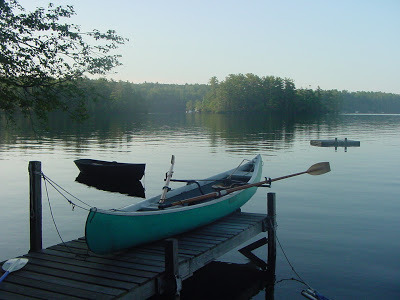
Water Striders
you are on the dock before mebefore the sun, impatient not waiting, shuffling toward the rowing-rigged canoelifting the stern to launchand nearly launching yourself
I steady the boatsteady your bodyease you instrap your feetshove you off watch you set the oarsand take your first longed-for pull
behind you I slip into the kayak paddle to reach you—alreadyhalfway to the small islandsand together stroking the waterskimming over the lake’s skinslicing and gliding the stillnesswe know this won’t last
the sun will crest the treesmotors will soundvoices will carrythe wind will churn the surface your strength will failand your senses, toocast to lake floor depthslike stones dropping down to mussels poking through sandand leaves caught in crevicesof cool granite shelves
so we pullagainst the waterpush against the waterskim over the watertaking this lakeone more morning
(c) Holly Thompson All Rights Reserved

Water Striders
you are on the dock before mebefore the sun, impatient not waiting, shuffling toward the rowing-rigged canoelifting the stern to launchand nearly launching yourself
I steady the boatsteady your bodyease you instrap your feetshove you off watch you set the oarsand take your first longed-for pull
behind you I slip into the kayak paddle to reach you—alreadyhalfway to the small islandsand together stroking the waterskimming over the lake’s skinslicing and gliding the stillnesswe know this won’t last
the sun will crest the treesmotors will soundvoices will carrythe wind will churn the surface your strength will failand your senses, toocast to lake floor depthslike stones dropping down to mussels poking through sandand leaves caught in crevicesof cool granite shelves
so we pullagainst the waterpush against the waterskim over the watertaking this lakeone more morning
(c) Holly Thompson All Rights Reserved
Published on June 16, 2013 17:27
June 13, 2013
My Sister: Climbing Against the Odds for the Breast Cancer Fund
This coming week is a momentous one for my sister, Pam Thompson, soon to fly to California for the Breast Cancer Fund's mountaineering expedition Climb Against the Odds on Mount Shasta. In March, I had the chance to see my sister in action and I tried keeping up with her as she trained, hiking and running up and down the hills of Milton, Massachusetts, with large bottles of water in her backpack for weights. Pam's challenges with breast cancer, as well as those faced recently by other relatives and friends, were the impetus for me to include the breast cancer challenges faced by Emma's mother in my verse novel The Language Inside.
This week the Harvard Gazette features Pam and the upcoming Mount Shasta ascent.
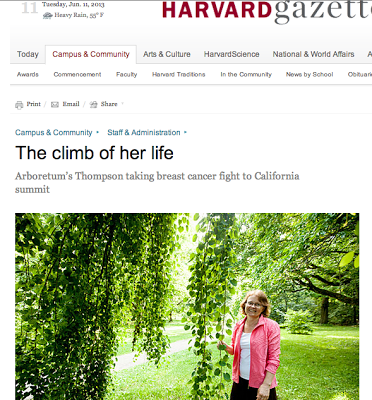
The nonprofit Breast Cancer Fund is dedicated to exposing and eliminating the environmental causes of breast cancer. In addition to training for the climb and her work at Boston's Arnold Arboretum, Pam has been busy fundraising for the Breast Cancer Fund.
I'm so proud of my sister climbing against the odds. On June 19, the day of the Mt. Shasta summit attempt, I'll definitely go out for a solidarity hike here in Japan, rain or shine. With each step, I'll be wishing Pam a safe and smooth ascent and descent. And I'll be hoping she gets that incredible view from the top she's been dreaming of.
This week the Harvard Gazette features Pam and the upcoming Mount Shasta ascent.

The nonprofit Breast Cancer Fund is dedicated to exposing and eliminating the environmental causes of breast cancer. In addition to training for the climb and her work at Boston's Arnold Arboretum, Pam has been busy fundraising for the Breast Cancer Fund.
I'm so proud of my sister climbing against the odds. On June 19, the day of the Mt. Shasta summit attempt, I'll definitely go out for a solidarity hike here in Japan, rain or shine. With each step, I'll be wishing Pam a safe and smooth ascent and descent. And I'll be hoping she gets that incredible view from the top she's been dreaming of.
Published on June 13, 2013 05:43
June 11, 2013
COETAIL: Multimedia Poetry Unit Plan
Another post toward obtaining my Certificate in Educational Technology and Information Literacy (COETAIL)
For my final project for Course 2 of the COETAIL program, I focused on creating a unit plan for my author writing residency visits to schools. I visit schools that barely have electricity as well as schools that have 1:1 programs with a laptop or iPad for each student. This unit plan, admittedly, is for schools in which students have easy access to the internet and computers, though not necessarily 1:1.
When I do author visits to schools, we often work on poetry projects, and in some residencies I work with the students to create not just drafts of poems, but revised and polished poems ready for sharing. Beyond sharing in print or online publications or blogposts of text only, I'm eager to see students working in multimedia formats--audio recording plus video; audio recording plus images; images plus text; and other combinations--to help make poetry come alive.
In order to develop this unit, however, I had to get my feet wet in multimedia poetry. I've long used PowerPoint to share poetry with students, but I had yet to create my own recordings or projects with iMovie or YouTube Editor or other platforms. My aim was to create a selection five or six projects with different combinations of media, but I had to scale back to several projects, two of which, created with iMovie, I've shared in the unit plan below as examples for students, in combination with the many other examples by other poets and creators shared in my previous multimedia poetry blogpost.
Here is my example of a themed project "Running Poems."
And here is my example project of a narrative poem "Cod."
Here is the link to the Multimedia Poetry Unit I designed, also embedded below (which, apologies, looks absurd embedded in this narrow theme for this blog).
Reflecting on this unit plan and my multimedia poetry projects, I realize that I should have started creating multimedia poetry ages ago. I loved working on this! I see so many possibilities for motivating and inspiring students to create poems that can then be further enhanced by technology and shared beyond the classroom or school.
I discovered my own shortcomings--insufficient iMovie editing experience; difficulty reading without text in front of me; my own slow perfectionist approach. I was made aware of the areas in which I need to experiment more so that leading this sort of project as a guest author in a school will go smoothly.
I see so many applications for this multimedia poetry unit--within language and literature classes and EFL/ESL/EAL programs; as narrative or other types of poetry projects; or as themed projects in connection with community service or international volunteering. I look forward to experimenting more with poetry and technology in the classroom and developing more of my own examples of tech-enhanced poems to share.
For my final project for Course 2 of the COETAIL program, I focused on creating a unit plan for my author writing residency visits to schools. I visit schools that barely have electricity as well as schools that have 1:1 programs with a laptop or iPad for each student. This unit plan, admittedly, is for schools in which students have easy access to the internet and computers, though not necessarily 1:1.
When I do author visits to schools, we often work on poetry projects, and in some residencies I work with the students to create not just drafts of poems, but revised and polished poems ready for sharing. Beyond sharing in print or online publications or blogposts of text only, I'm eager to see students working in multimedia formats--audio recording plus video; audio recording plus images; images plus text; and other combinations--to help make poetry come alive.
In order to develop this unit, however, I had to get my feet wet in multimedia poetry. I've long used PowerPoint to share poetry with students, but I had yet to create my own recordings or projects with iMovie or YouTube Editor or other platforms. My aim was to create a selection five or six projects with different combinations of media, but I had to scale back to several projects, two of which, created with iMovie, I've shared in the unit plan below as examples for students, in combination with the many other examples by other poets and creators shared in my previous multimedia poetry blogpost.
Here is my example of a themed project "Running Poems."
And here is my example project of a narrative poem "Cod."
Here is the link to the Multimedia Poetry Unit I designed, also embedded below (which, apologies, looks absurd embedded in this narrow theme for this blog).
Reflecting on this unit plan and my multimedia poetry projects, I realize that I should have started creating multimedia poetry ages ago. I loved working on this! I see so many possibilities for motivating and inspiring students to create poems that can then be further enhanced by technology and shared beyond the classroom or school.
I discovered my own shortcomings--insufficient iMovie editing experience; difficulty reading without text in front of me; my own slow perfectionist approach. I was made aware of the areas in which I need to experiment more so that leading this sort of project as a guest author in a school will go smoothly.
I see so many applications for this multimedia poetry unit--within language and literature classes and EFL/ESL/EAL programs; as narrative or other types of poetry projects; or as themed projects in connection with community service or international volunteering. I look forward to experimenting more with poetry and technology in the classroom and developing more of my own examples of tech-enhanced poems to share.
Published on June 11, 2013 23:04
June 9, 2013
COETAIL: Branding a Love of Writing and Story
Another post toward obtaining my Certificate in Educational Technology and Information Literacy (COETAIL)
After thinking about Seth Godin's words about Tribe Management and reading through Tribes and Tribes: The Case Studies and mulling over Mashable's Personal Branding 101, I find myself comfortable with thinking about tribes and communities, but less comfortable with branding. Why?
Tribes are about belonging and about common aims and interests. Branding is about selling your product or your ideas. And I often find myself at odds with trying to market my products--my books-- since my true love is not marketing or the business of books but, rather, writing fiction--sculpting words into stories, in prose and in verse.
Authors are supposed to have an author brand; each book (or series) may also have its own brand. By now I have something of a fiction brand--I think Terry Hong nailed it in the BookDragon review of The Language Inside: "I’m growing rather partial to Holly Thompson‘s ethnic-blending, boundary-crossing, expectation-defying titles for young adults." Thank you, Terry!
I'm definitely more comfortable thinking about personal branding and tribe management concepts when I think of "selling" my ideas rather than a product. So, what ideas am I trying to "sell"? As an educator, what I try to sell to my "customers"--my students--is a love of writing.
Love of writing is the foundation of so many of the tribes I belong to: SCBWI, SCBWI Japan, AFCC, chat groups like #KidLitChat or #YALitChat, communities of poet educators, and on and on.
Without doubt I could better define my author/writing teacher/educator brand and could improve at communicating just how I "sell" the love of writing in both verse and prose to students at my university and at the elementary, middle and high schools I visit. I can redo my website and blog design. I can share more about the ways I'm constantly adapting my lessons, workshops and presentations; more about how my students build stories and poems; more about my writing process; and more about the multimedia poetry projects I'm developing.
But of course, after all this COETAIL homework reading, what do you suppose lingers with me? Not Godin's words, not a particular how-to guide to branding, but rather the stories within Tribes: The Case Studies. Read through the many "case studies," and you, too, will start thinking of your own tribe stories, tales of a tribe you belong to or established or fell into by accident, maybe even literally. Story is everything, our mirror on the world, our means of visiting other worlds. As the late Chinua Achebe said, "The story is our escort, without it we are blind."
So here is a little story. As a young teen I was confident of nothing, but I was writing poems, finding my love of words. At a family gathering, I sat down in an armchair, and an aunt who was active in the arts knelt down on the floor beside me (insisting on kneeling). She asked what I wanted to be. "A writer," I whispered, startling both myself and her at the confession. "Perfect," she answered. "We don't have enough good writers." As if she just assumed I'd be a "good" writer. Her assurance and faith in me that day we talked favorite authors and poets and story and drama gave me a shot of confidence that had been missing, the courage to try to gain admission to the tribe of writers.
Now when I visit middle and high schools, at the end of each talk there are usually one or two students who linger, hand me a poem or a chapter from their novel-in-progress, and breathlessly confess that they, too, want to be a writer. "Perfect," I answer. "We don't have enough good writers," and we talk writing like they're already in the tribe. I know they'll be "good" if they believe they will; they'll be "good" if they love it enough.
After thinking about Seth Godin's words about Tribe Management and reading through Tribes and Tribes: The Case Studies and mulling over Mashable's Personal Branding 101, I find myself comfortable with thinking about tribes and communities, but less comfortable with branding. Why?
Tribes are about belonging and about common aims and interests. Branding is about selling your product or your ideas. And I often find myself at odds with trying to market my products--my books-- since my true love is not marketing or the business of books but, rather, writing fiction--sculpting words into stories, in prose and in verse.
Authors are supposed to have an author brand; each book (or series) may also have its own brand. By now I have something of a fiction brand--I think Terry Hong nailed it in the BookDragon review of The Language Inside: "I’m growing rather partial to Holly Thompson‘s ethnic-blending, boundary-crossing, expectation-defying titles for young adults." Thank you, Terry!
I'm definitely more comfortable thinking about personal branding and tribe management concepts when I think of "selling" my ideas rather than a product. So, what ideas am I trying to "sell"? As an educator, what I try to sell to my "customers"--my students--is a love of writing.
Love of writing is the foundation of so many of the tribes I belong to: SCBWI, SCBWI Japan, AFCC, chat groups like #KidLitChat or #YALitChat, communities of poet educators, and on and on.
Without doubt I could better define my author/writing teacher/educator brand and could improve at communicating just how I "sell" the love of writing in both verse and prose to students at my university and at the elementary, middle and high schools I visit. I can redo my website and blog design. I can share more about the ways I'm constantly adapting my lessons, workshops and presentations; more about how my students build stories and poems; more about my writing process; and more about the multimedia poetry projects I'm developing.
But of course, after all this COETAIL homework reading, what do you suppose lingers with me? Not Godin's words, not a particular how-to guide to branding, but rather the stories within Tribes: The Case Studies. Read through the many "case studies," and you, too, will start thinking of your own tribe stories, tales of a tribe you belong to or established or fell into by accident, maybe even literally. Story is everything, our mirror on the world, our means of visiting other worlds. As the late Chinua Achebe said, "The story is our escort, without it we are blind."
So here is a little story. As a young teen I was confident of nothing, but I was writing poems, finding my love of words. At a family gathering, I sat down in an armchair, and an aunt who was active in the arts knelt down on the floor beside me (insisting on kneeling). She asked what I wanted to be. "A writer," I whispered, startling both myself and her at the confession. "Perfect," she answered. "We don't have enough good writers." As if she just assumed I'd be a "good" writer. Her assurance and faith in me that day we talked favorite authors and poets and story and drama gave me a shot of confidence that had been missing, the courage to try to gain admission to the tribe of writers.
Now when I visit middle and high schools, at the end of each talk there are usually one or two students who linger, hand me a poem or a chapter from their novel-in-progress, and breathlessly confess that they, too, want to be a writer. "Perfect," I answer. "We don't have enough good writers," and we talk writing like they're already in the tribe. I know they'll be "good" if they believe they will; they'll be "good" if they love it enough.
Published on June 09, 2013 01:52
June 5, 2013
COETAIL: Poetry, Video and Social Media
Another post toward obtaining my Certificate in Educational Technology and Information Literacy (COETAIL)
As an author who often does school visits that include poetry workshops, I'm often asked if there can be a culminating publication of works created during or after my visit. Of course! is my answer. But there's no reason to think only of print projects. Poetry, tech tools and social media combine easily. In addition to readings, slams, and magazines, I'd like to see multimedia projects become end products of my residencies and school visits. I'm steadily working on my own poetry projects to share via social media and to have ready to share with students. Meanwhile, here are some samples of inspiration that we can offer students.
Videos of poets reading poems such as those by Michael Rosen here performing "Mum's Dead Coat".
Or Benjamin Zephaniah performing "Faceless"
Longer spoken word performances like those shared in the TED Spoken-word Fireworks playlist and Phil Kaye's bicultural poem "Teeth":
and the amazing Hollie McNish performing Mathematics.
Multimedia projects like these Elucidata projects created by BU Creative Writing Students. Elementary school students can also make blogged videos with images like the list poetry blogs and videos shared in Media Literacy Projects in MediaSpot.org. Collaborative poem performances, such as When Love Arrives by Sarah Kay and Phil Kaye, later made into a typography video by Melvin Alvarez:
Poem plus video plus images plus music such as Bill Yake's "Praising the Fish":Text plus video plus music such as Sandra Beasly's "I Don't Fear Death"Video poems such as those collected on Moving Poems including "The Barking Horse" by Patrick Sheridan.
Poets&Writers in its offering of six video poems suggests that "the video poem may be ushering a whole new demographic to poetry." The comments section offers plenty more links.
One challenge in the classroom when taking on such projects, even with the simplest tools, is that more time may get devoted to videography or fiddling with iMovie or YouTube Editor. As I embark on these projects in the classrooms I visit, I want to ensure that the students are given ample time to focus on their words first. I want to ensure time for their poems to percolate and grow--time for thoughtful, focused revision, feedback and more revision. Then, students will be invited to explore creative ways to share their poems with the world.
As an author who often does school visits that include poetry workshops, I'm often asked if there can be a culminating publication of works created during or after my visit. Of course! is my answer. But there's no reason to think only of print projects. Poetry, tech tools and social media combine easily. In addition to readings, slams, and magazines, I'd like to see multimedia projects become end products of my residencies and school visits. I'm steadily working on my own poetry projects to share via social media and to have ready to share with students. Meanwhile, here are some samples of inspiration that we can offer students.
Videos of poets reading poems such as those by Michael Rosen here performing "Mum's Dead Coat".
Or Benjamin Zephaniah performing "Faceless"
Longer spoken word performances like those shared in the TED Spoken-word Fireworks playlist and Phil Kaye's bicultural poem "Teeth":
and the amazing Hollie McNish performing Mathematics.
Multimedia projects like these Elucidata projects created by BU Creative Writing Students. Elementary school students can also make blogged videos with images like the list poetry blogs and videos shared in Media Literacy Projects in MediaSpot.org. Collaborative poem performances, such as When Love Arrives by Sarah Kay and Phil Kaye, later made into a typography video by Melvin Alvarez:
Poem plus video plus images plus music such as Bill Yake's "Praising the Fish":Text plus video plus music such as Sandra Beasly's "I Don't Fear Death"Video poems such as those collected on Moving Poems including "The Barking Horse" by Patrick Sheridan.
Poets&Writers in its offering of six video poems suggests that "the video poem may be ushering a whole new demographic to poetry." The comments section offers plenty more links.
One challenge in the classroom when taking on such projects, even with the simplest tools, is that more time may get devoted to videography or fiddling with iMovie or YouTube Editor. As I embark on these projects in the classrooms I visit, I want to ensure that the students are given ample time to focus on their words first. I want to ensure time for their poems to percolate and grow--time for thoughtful, focused revision, feedback and more revision. Then, students will be invited to explore creative ways to share their poems with the world.
Published on June 05, 2013 23:00



